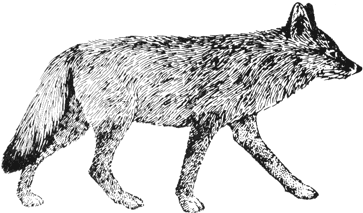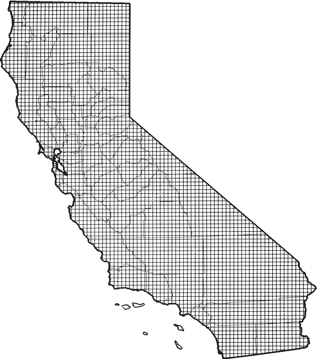
Coyote
Distribution, Abundance, and Seasonality
Common to abundant, permanent resident throughout the state (Grinnell et al. 1937). Occurs in almost all habitats and successional stages. Frequents open brush, scrub, shrub, and herbaceous habitats, and may be associated opportunistically with croplands. Also found in younger stands of deciduous and conifer forest and woodland with low to intermediate canopy, and shrub and grass understory.

Range Map
Specific Habitat Requirements
Feeding: An omnivorous opportunist. Eats primarily mice, rats, ground squirrels, gophers, lagomorphs, and carrion (Ferrel et al. 1953, Bekoff 1977). Takes some insects, reptiles, amphibians, fruits, and occasionally birds, their eggs, and deer fawns. Locally, some may take sheep and domestic fowl. Searches and pounces, stalks and chases, and may dig out prey. Hunts either solitarily, in pairs, or in small packs (family groups). Favors open habitats where it can chase down prey.
Cover: Brushy stands of vegetation, natural cavities, and suitable soil for the excavation of dens provide cover.
Reproduction: Will use natural cavities in rocky areas, hollow trees and logs, caves and holes. Also will dig dens, usually on brushy, south-facing slopes.
Water: Drinking water required.
Pattern: Suitable habitat is characterized by interspersions of brush and open areas, with free water.
Species Life History
Activity Patterns: Active yearlong. Mostly crepuscular and nocturnal, occasionally diurnal.
Seasonal Movements / Migration: Non-migratory. Movements vary with season. Often follows roads, trails fence lines, paths.
Home Range: Bekoff (1977) reported home ranges of 8-80 km? (3-31 mi?). Home ranges of males overlapped considerably, but those of females did not. In Sierra Co., home ranges varied from 10-100 km? (4-39 mi?) (Hawthorne 1971). Movements varied according to season.
Territory: Territoriality not substantiated (Bekoff 1977).
Reproduction: In California, mates from January to March. Gestation is about 63 days. Most young are born from March through May. One litter/yr of 5-6 average, ranging from 1-11, or more (Bekoff 1977). Young weaned at 5-7 wk, and leave parents at 6-9 mo (Bekoff 1977). Most males and females breed first in second yr. Pairs tend to remain together for yrs.
Niche: Coyotes are adaptable predators, found in most open habitats. They are tolerant of human activities, and adapt and adjust rapidly to perturbations and changes in their environment. Widespread efforts to control or reduce coyote numbers largely are unsuccessful (Connolly and Longhurst 1975, Bekoff 1977, 1978). They remain common to abundant throughout much of the state. Golden eagles, great horned owls, and mountain lions occasionally may kill coyotes. Coyotes host various ectoparasites and endoparasites, and occasionally may carry rabies.
Sources & References
California Department of Fish and Game, 1999.
California's Wildlife, Sacramento, CA.
Written by: G. Ahlborn, reviewed by: M. White, edited by: G. Ahlborn
Bekoff, M. 1977. Canis latrans. Mammal. Species No. 79. 9pp. Bekoff, M., ed. 1978. Coyotes. Academic Press, New York. 384pp. Camenzind, F. J. 1978. Behavioral ecology of coyotes on the National Elk Refuge, Jackson, Wyoming. Pages 267-294 in M. Bekoff, ed. Coyotes. Academic Press, New York. 384pp. Connoly, G. E., and W. M. Longhurst. 1975. The effects of control on coyote populatons. Univ. Calif. Div. Agric. Sci. Bull. No. 1972. Berkeley. 37pp. Ferrel, C. M., H. R. Leach, and D. F. Tillotson. 1953. Food habits of the coyote in California. Calif. Fish and Game. 39:301-341. Gier, H. T. 1975. Ecology and behavior of the coyote (Canis latrans). Pages 247-262 in M. W. Fox, ed. The wild canids. Van Nostrand Reinhold, New York. 508pp. Golightly, R. T., Jr. 1981. The comparative energetics of two desert canids; the coyote and the kit fox. Ph.D. Diss., Arizona State Univ., Tempe. 174pp. Grinnell, J., J. S. Dixon, and J. M. Linsdale. 1937. Fur-bearing mammals of California. 2 Vols. Univ. California Press, Berkeley. 777pp. Hawthorne, V. M. 1971. Coyote movements in Sagehen Creek Basin, northeastern California. Calif. Fish and Game 57:154-161. Hawthorne, V. M. 1972. Coyote food habits in Sagehen Creek Basin, northeastern California. Calif. Fish and Game 58:4-12. Knowlton, F. F. 1972. Preliminary interpretations of coyote population mechanics with some mangement implications. J. Wildl. Manage. 36:369-382.
California Animal Facts | California's Wildlife